Analysis of Managing Across Global Culture and Leadership Styles
VerifiedAdded on 2021/06/17
|12
|3454
|26
Essay
AI Summary
This essay delves into the multifaceted aspects of managing across global cultures, focusing on the critical issues of hierarchy and decision-making within organizations. Drawing insights from Erin Meyer's article, the essay examines the contrasting leadership styles and cultural nuances between different regions, such as the United States and Japan, highlighting the challenges and opportunities for global leaders. The analysis explores the impact of cultural differences on organizational behavior, emphasizing the importance of adapting leadership approaches to align with local values and expectations. The essay discusses various leadership models, including egalitarian and hierarchical approaches, and the influence of these models on employee engagement and innovation. It further investigates the decision-making processes in diverse cultural contexts, the importance of employee involvement, and the need for global leaders to understand the dynamics of high-context and low-context cultures. By analyzing the implications of these factors, the essay provides a comprehensive overview of the complexities involved in managing across global cultures, emphasizing the need for adaptability, cultural sensitivity, and strategic decision-making to achieve organizational success.
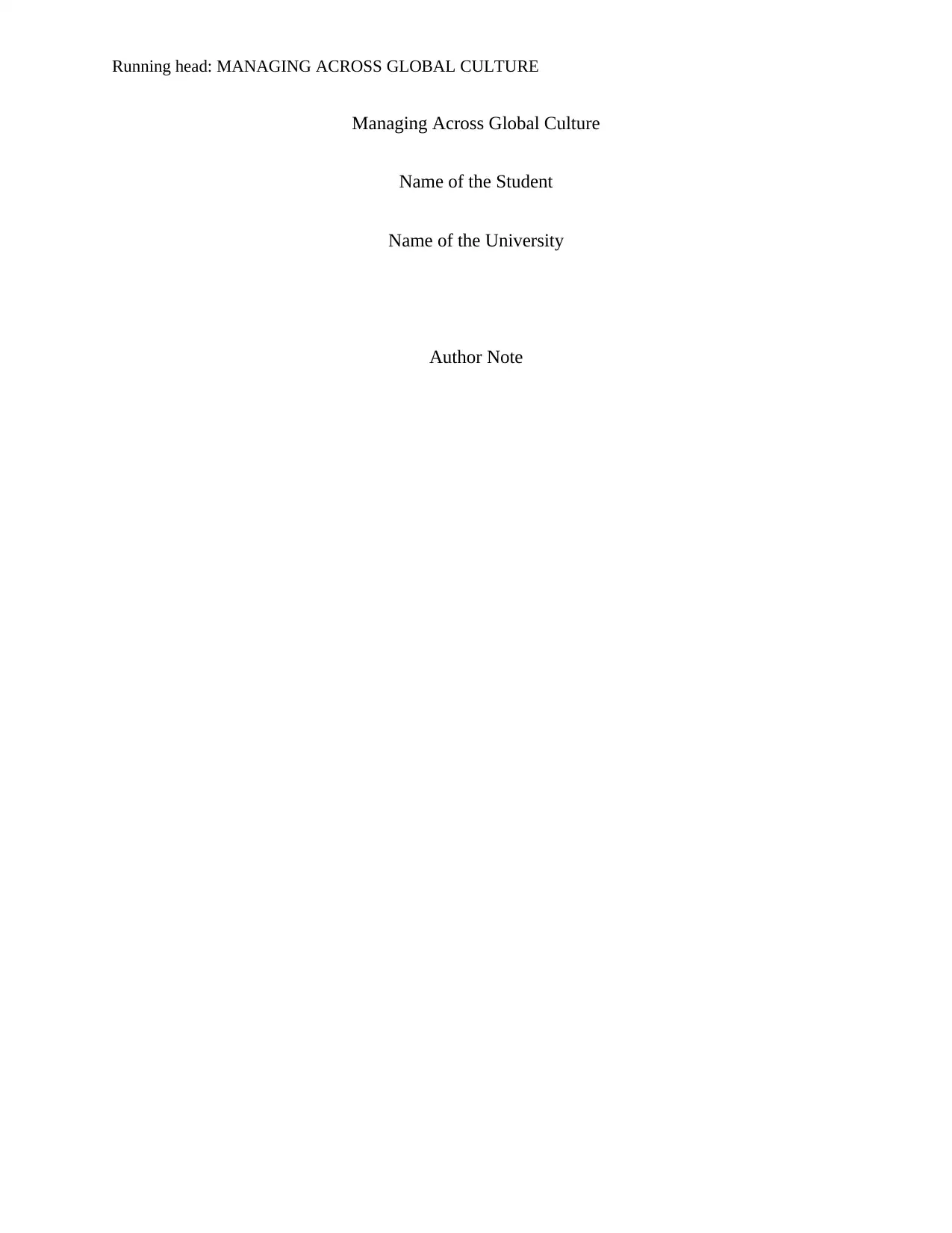
Running head: MANAGING ACROSS GLOBAL CULTURE
Managing Across Global Culture
Name of the Student
Name of the University
Author Note
Managing Across Global Culture
Name of the Student
Name of the University
Author Note
Paraphrase This Document
Need a fresh take? Get an instant paraphrase of this document with our AI Paraphraser
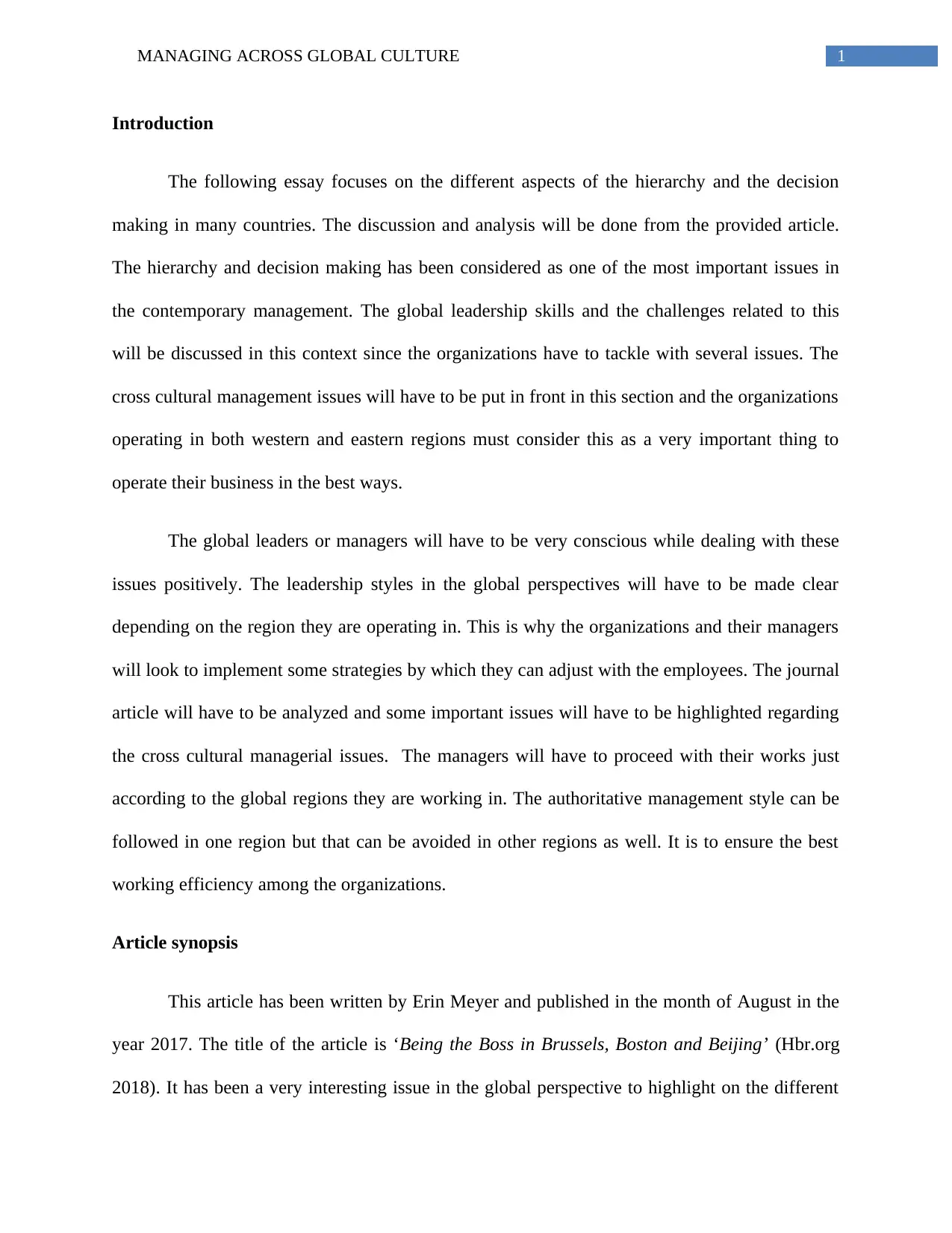
1MANAGING ACROSS GLOBAL CULTURE
Introduction
The following essay focuses on the different aspects of the hierarchy and the decision
making in many countries. The discussion and analysis will be done from the provided article.
The hierarchy and decision making has been considered as one of the most important issues in
the contemporary management. The global leadership skills and the challenges related to this
will be discussed in this context since the organizations have to tackle with several issues. The
cross cultural management issues will have to be put in front in this section and the organizations
operating in both western and eastern regions must consider this as a very important thing to
operate their business in the best ways.
The global leaders or managers will have to be very conscious while dealing with these
issues positively. The leadership styles in the global perspectives will have to be made clear
depending on the region they are operating in. This is why the organizations and their managers
will look to implement some strategies by which they can adjust with the employees. The journal
article will have to be analyzed and some important issues will have to be highlighted regarding
the cross cultural managerial issues. The managers will have to proceed with their works just
according to the global regions they are working in. The authoritative management style can be
followed in one region but that can be avoided in other regions as well. It is to ensure the best
working efficiency among the organizations.
Article synopsis
This article has been written by Erin Meyer and published in the month of August in the
year 2017. The title of the article is ‘Being the Boss in Brussels, Boston and Beijing’ (Hbr.org
2018). It has been a very interesting issue in the global perspective to highlight on the different
Introduction
The following essay focuses on the different aspects of the hierarchy and the decision
making in many countries. The discussion and analysis will be done from the provided article.
The hierarchy and decision making has been considered as one of the most important issues in
the contemporary management. The global leadership skills and the challenges related to this
will be discussed in this context since the organizations have to tackle with several issues. The
cross cultural management issues will have to be put in front in this section and the organizations
operating in both western and eastern regions must consider this as a very important thing to
operate their business in the best ways.
The global leaders or managers will have to be very conscious while dealing with these
issues positively. The leadership styles in the global perspectives will have to be made clear
depending on the region they are operating in. This is why the organizations and their managers
will look to implement some strategies by which they can adjust with the employees. The journal
article will have to be analyzed and some important issues will have to be highlighted regarding
the cross cultural managerial issues. The managers will have to proceed with their works just
according to the global regions they are working in. The authoritative management style can be
followed in one region but that can be avoided in other regions as well. It is to ensure the best
working efficiency among the organizations.
Article synopsis
This article has been written by Erin Meyer and published in the month of August in the
year 2017. The title of the article is ‘Being the Boss in Brussels, Boston and Beijing’ (Hbr.org
2018). It has been a very interesting issue in the global perspective to highlight on the different
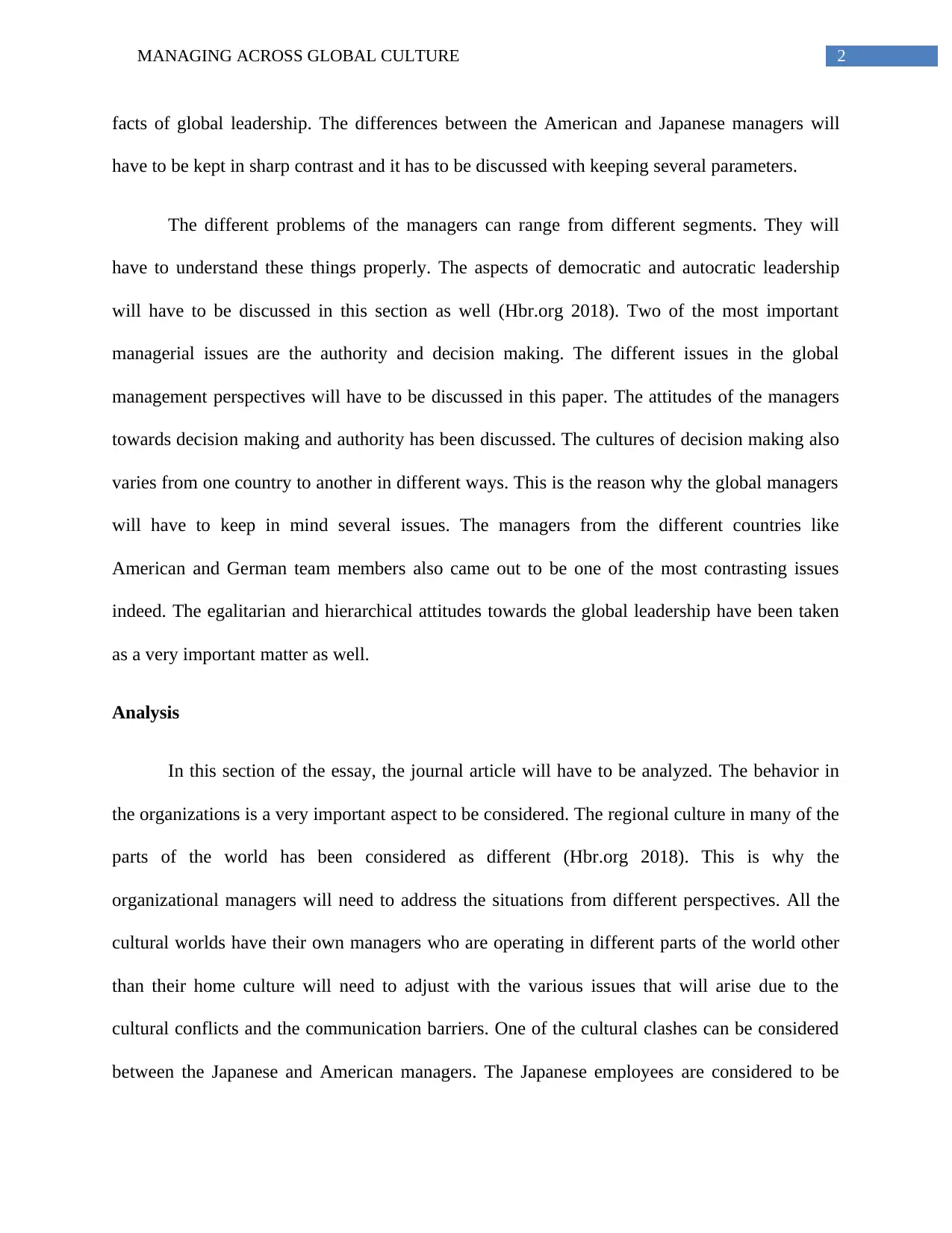
2MANAGING ACROSS GLOBAL CULTURE
facts of global leadership. The differences between the American and Japanese managers will
have to be kept in sharp contrast and it has to be discussed with keeping several parameters.
The different problems of the managers can range from different segments. They will
have to understand these things properly. The aspects of democratic and autocratic leadership
will have to be discussed in this section as well (Hbr.org 2018). Two of the most important
managerial issues are the authority and decision making. The different issues in the global
management perspectives will have to be discussed in this paper. The attitudes of the managers
towards decision making and authority has been discussed. The cultures of decision making also
varies from one country to another in different ways. This is the reason why the global managers
will have to keep in mind several issues. The managers from the different countries like
American and German team members also came out to be one of the most contrasting issues
indeed. The egalitarian and hierarchical attitudes towards the global leadership have been taken
as a very important matter as well.
Analysis
In this section of the essay, the journal article will have to be analyzed. The behavior in
the organizations is a very important aspect to be considered. The regional culture in many of the
parts of the world has been considered as different (Hbr.org 2018). This is why the
organizational managers will need to address the situations from different perspectives. All the
cultural worlds have their own managers who are operating in different parts of the world other
than their home culture will need to adjust with the various issues that will arise due to the
cultural conflicts and the communication barriers. One of the cultural clashes can be considered
between the Japanese and American managers. The Japanese employees are considered to be
facts of global leadership. The differences between the American and Japanese managers will
have to be kept in sharp contrast and it has to be discussed with keeping several parameters.
The different problems of the managers can range from different segments. They will
have to understand these things properly. The aspects of democratic and autocratic leadership
will have to be discussed in this section as well (Hbr.org 2018). Two of the most important
managerial issues are the authority and decision making. The different issues in the global
management perspectives will have to be discussed in this paper. The attitudes of the managers
towards decision making and authority has been discussed. The cultures of decision making also
varies from one country to another in different ways. This is the reason why the global managers
will have to keep in mind several issues. The managers from the different countries like
American and German team members also came out to be one of the most contrasting issues
indeed. The egalitarian and hierarchical attitudes towards the global leadership have been taken
as a very important matter as well.
Analysis
In this section of the essay, the journal article will have to be analyzed. The behavior in
the organizations is a very important aspect to be considered. The regional culture in many of the
parts of the world has been considered as different (Hbr.org 2018). This is why the
organizational managers will need to address the situations from different perspectives. All the
cultural worlds have their own managers who are operating in different parts of the world other
than their home culture will need to adjust with the various issues that will arise due to the
cultural conflicts and the communication barriers. One of the cultural clashes can be considered
between the Japanese and American managers. The Japanese employees are considered to be
⊘ This is a preview!⊘
Do you want full access?
Subscribe today to unlock all pages.

Trusted by 1+ million students worldwide
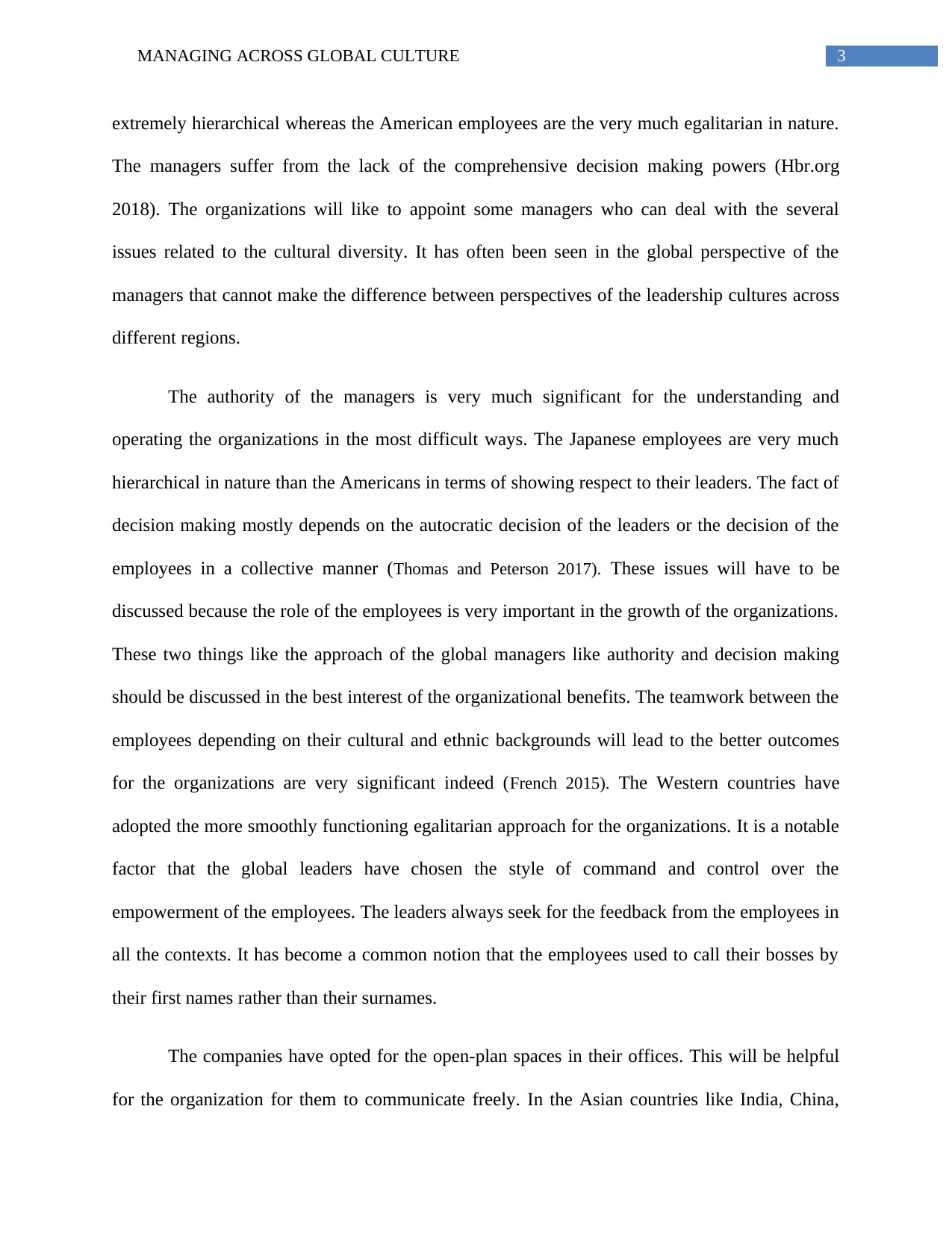
3MANAGING ACROSS GLOBAL CULTURE
extremely hierarchical whereas the American employees are the very much egalitarian in nature.
The managers suffer from the lack of the comprehensive decision making powers (Hbr.org
2018). The organizations will like to appoint some managers who can deal with the several
issues related to the cultural diversity. It has often been seen in the global perspective of the
managers that cannot make the difference between perspectives of the leadership cultures across
different regions.
The authority of the managers is very much significant for the understanding and
operating the organizations in the most difficult ways. The Japanese employees are very much
hierarchical in nature than the Americans in terms of showing respect to their leaders. The fact of
decision making mostly depends on the autocratic decision of the leaders or the decision of the
employees in a collective manner (Thomas and Peterson 2017). These issues will have to be
discussed because the role of the employees is very important in the growth of the organizations.
These two things like the approach of the global managers like authority and decision making
should be discussed in the best interest of the organizational benefits. The teamwork between the
employees depending on their cultural and ethnic backgrounds will lead to the better outcomes
for the organizations are very significant indeed (French 2015). The Western countries have
adopted the more smoothly functioning egalitarian approach for the organizations. It is a notable
factor that the global leaders have chosen the style of command and control over the
empowerment of the employees. The leaders always seek for the feedback from the employees in
all the contexts. It has become a common notion that the employees used to call their bosses by
their first names rather than their surnames.
The companies have opted for the open-plan spaces in their offices. This will be helpful
for the organization for them to communicate freely. In the Asian countries like India, China,
extremely hierarchical whereas the American employees are the very much egalitarian in nature.
The managers suffer from the lack of the comprehensive decision making powers (Hbr.org
2018). The organizations will like to appoint some managers who can deal with the several
issues related to the cultural diversity. It has often been seen in the global perspective of the
managers that cannot make the difference between perspectives of the leadership cultures across
different regions.
The authority of the managers is very much significant for the understanding and
operating the organizations in the most difficult ways. The Japanese employees are very much
hierarchical in nature than the Americans in terms of showing respect to their leaders. The fact of
decision making mostly depends on the autocratic decision of the leaders or the decision of the
employees in a collective manner (Thomas and Peterson 2017). These issues will have to be
discussed because the role of the employees is very important in the growth of the organizations.
These two things like the approach of the global managers like authority and decision making
should be discussed in the best interest of the organizational benefits. The teamwork between the
employees depending on their cultural and ethnic backgrounds will lead to the better outcomes
for the organizations are very significant indeed (French 2015). The Western countries have
adopted the more smoothly functioning egalitarian approach for the organizations. It is a notable
factor that the global leaders have chosen the style of command and control over the
empowerment of the employees. The leaders always seek for the feedback from the employees in
all the contexts. It has become a common notion that the employees used to call their bosses by
their first names rather than their surnames.
The companies have opted for the open-plan spaces in their offices. This will be helpful
for the organization for them to communicate freely. In the Asian countries like India, China,
Paraphrase This Document
Need a fresh take? Get an instant paraphrase of this document with our AI Paraphraser
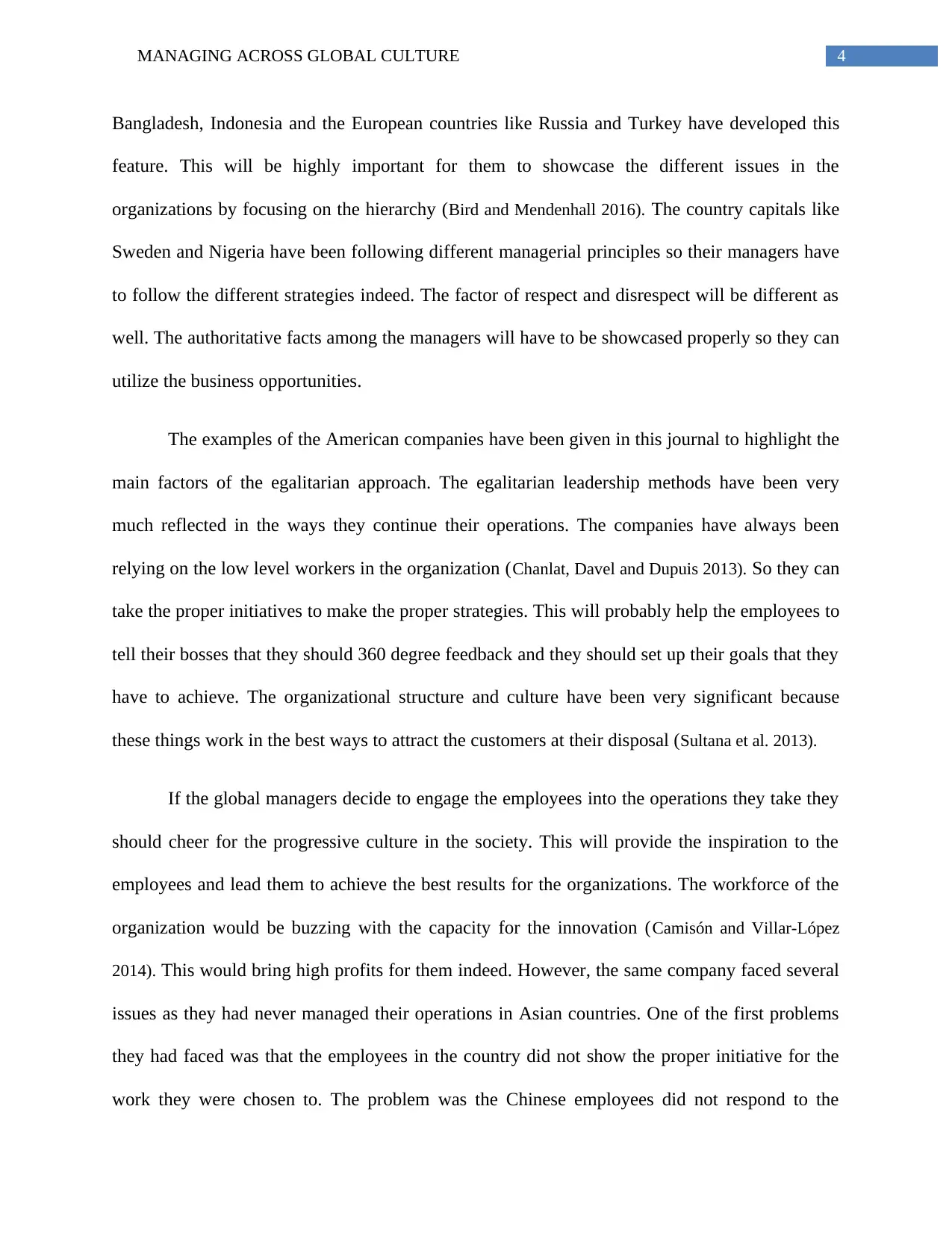
4MANAGING ACROSS GLOBAL CULTURE
Bangladesh, Indonesia and the European countries like Russia and Turkey have developed this
feature. This will be highly important for them to showcase the different issues in the
organizations by focusing on the hierarchy (Bird and Mendenhall 2016). The country capitals like
Sweden and Nigeria have been following different managerial principles so their managers have
to follow the different strategies indeed. The factor of respect and disrespect will be different as
well. The authoritative facts among the managers will have to be showcased properly so they can
utilize the business opportunities.
The examples of the American companies have been given in this journal to highlight the
main factors of the egalitarian approach. The egalitarian leadership methods have been very
much reflected in the ways they continue their operations. The companies have always been
relying on the low level workers in the organization (Chanlat, Davel and Dupuis 2013). So they can
take the proper initiatives to make the proper strategies. This will probably help the employees to
tell their bosses that they should 360 degree feedback and they should set up their goals that they
have to achieve. The organizational structure and culture have been very significant because
these things work in the best ways to attract the customers at their disposal (Sultana et al. 2013).
If the global managers decide to engage the employees into the operations they take they
should cheer for the progressive culture in the society. This will provide the inspiration to the
employees and lead them to achieve the best results for the organizations. The workforce of the
organization would be buzzing with the capacity for the innovation (Camisón and Villar-López
2014). This would bring high profits for them indeed. However, the same company faced several
issues as they had never managed their operations in Asian countries. One of the first problems
they had faced was that the employees in the country did not show the proper initiative for the
work they were chosen to. The problem was the Chinese employees did not respond to the
Bangladesh, Indonesia and the European countries like Russia and Turkey have developed this
feature. This will be highly important for them to showcase the different issues in the
organizations by focusing on the hierarchy (Bird and Mendenhall 2016). The country capitals like
Sweden and Nigeria have been following different managerial principles so their managers have
to follow the different strategies indeed. The factor of respect and disrespect will be different as
well. The authoritative facts among the managers will have to be showcased properly so they can
utilize the business opportunities.
The examples of the American companies have been given in this journal to highlight the
main factors of the egalitarian approach. The egalitarian leadership methods have been very
much reflected in the ways they continue their operations. The companies have always been
relying on the low level workers in the organization (Chanlat, Davel and Dupuis 2013). So they can
take the proper initiatives to make the proper strategies. This will probably help the employees to
tell their bosses that they should 360 degree feedback and they should set up their goals that they
have to achieve. The organizational structure and culture have been very significant because
these things work in the best ways to attract the customers at their disposal (Sultana et al. 2013).
If the global managers decide to engage the employees into the operations they take they
should cheer for the progressive culture in the society. This will provide the inspiration to the
employees and lead them to achieve the best results for the organizations. The workforce of the
organization would be buzzing with the capacity for the innovation (Camisón and Villar-López
2014). This would bring high profits for them indeed. However, the same company faced several
issues as they had never managed their operations in Asian countries. One of the first problems
they had faced was that the employees in the country did not show the proper initiative for the
work they were chosen to. The problem was the Chinese employees did not respond to the
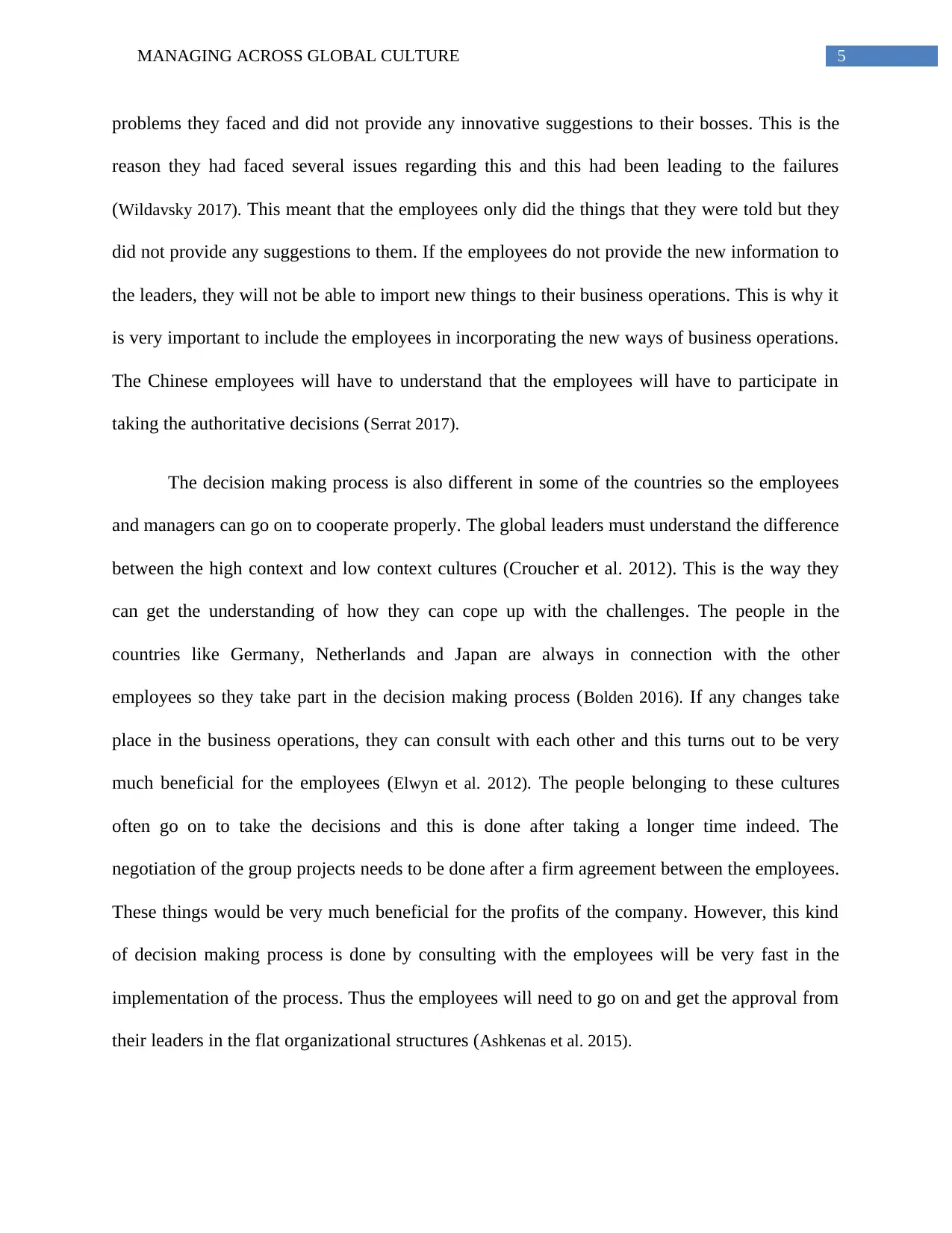
5MANAGING ACROSS GLOBAL CULTURE
problems they faced and did not provide any innovative suggestions to their bosses. This is the
reason they had faced several issues regarding this and this had been leading to the failures
(Wildavsky 2017). This meant that the employees only did the things that they were told but they
did not provide any suggestions to them. If the employees do not provide the new information to
the leaders, they will not be able to import new things to their business operations. This is why it
is very important to include the employees in incorporating the new ways of business operations.
The Chinese employees will have to understand that the employees will have to participate in
taking the authoritative decisions (Serrat 2017).
The decision making process is also different in some of the countries so the employees
and managers can go on to cooperate properly. The global leaders must understand the difference
between the high context and low context cultures (Croucher et al. 2012). This is the way they
can get the understanding of how they can cope up with the challenges. The people in the
countries like Germany, Netherlands and Japan are always in connection with the other
employees so they take part in the decision making process (Bolden 2016). If any changes take
place in the business operations, they can consult with each other and this turns out to be very
much beneficial for the employees (Elwyn et al. 2012). The people belonging to these cultures
often go on to take the decisions and this is done after taking a longer time indeed. The
negotiation of the group projects needs to be done after a firm agreement between the employees.
These things would be very much beneficial for the profits of the company. However, this kind
of decision making process is done by consulting with the employees will be very fast in the
implementation of the process. Thus the employees will need to go on and get the approval from
their leaders in the flat organizational structures (Ashkenas et al. 2015).
problems they faced and did not provide any innovative suggestions to their bosses. This is the
reason they had faced several issues regarding this and this had been leading to the failures
(Wildavsky 2017). This meant that the employees only did the things that they were told but they
did not provide any suggestions to them. If the employees do not provide the new information to
the leaders, they will not be able to import new things to their business operations. This is why it
is very important to include the employees in incorporating the new ways of business operations.
The Chinese employees will have to understand that the employees will have to participate in
taking the authoritative decisions (Serrat 2017).
The decision making process is also different in some of the countries so the employees
and managers can go on to cooperate properly. The global leaders must understand the difference
between the high context and low context cultures (Croucher et al. 2012). This is the way they
can get the understanding of how they can cope up with the challenges. The people in the
countries like Germany, Netherlands and Japan are always in connection with the other
employees so they take part in the decision making process (Bolden 2016). If any changes take
place in the business operations, they can consult with each other and this turns out to be very
much beneficial for the employees (Elwyn et al. 2012). The people belonging to these cultures
often go on to take the decisions and this is done after taking a longer time indeed. The
negotiation of the group projects needs to be done after a firm agreement between the employees.
These things would be very much beneficial for the profits of the company. However, this kind
of decision making process is done by consulting with the employees will be very fast in the
implementation of the process. Thus the employees will need to go on and get the approval from
their leaders in the flat organizational structures (Ashkenas et al. 2015).
⊘ This is a preview!⊘
Do you want full access?
Subscribe today to unlock all pages.

Trusted by 1+ million students worldwide
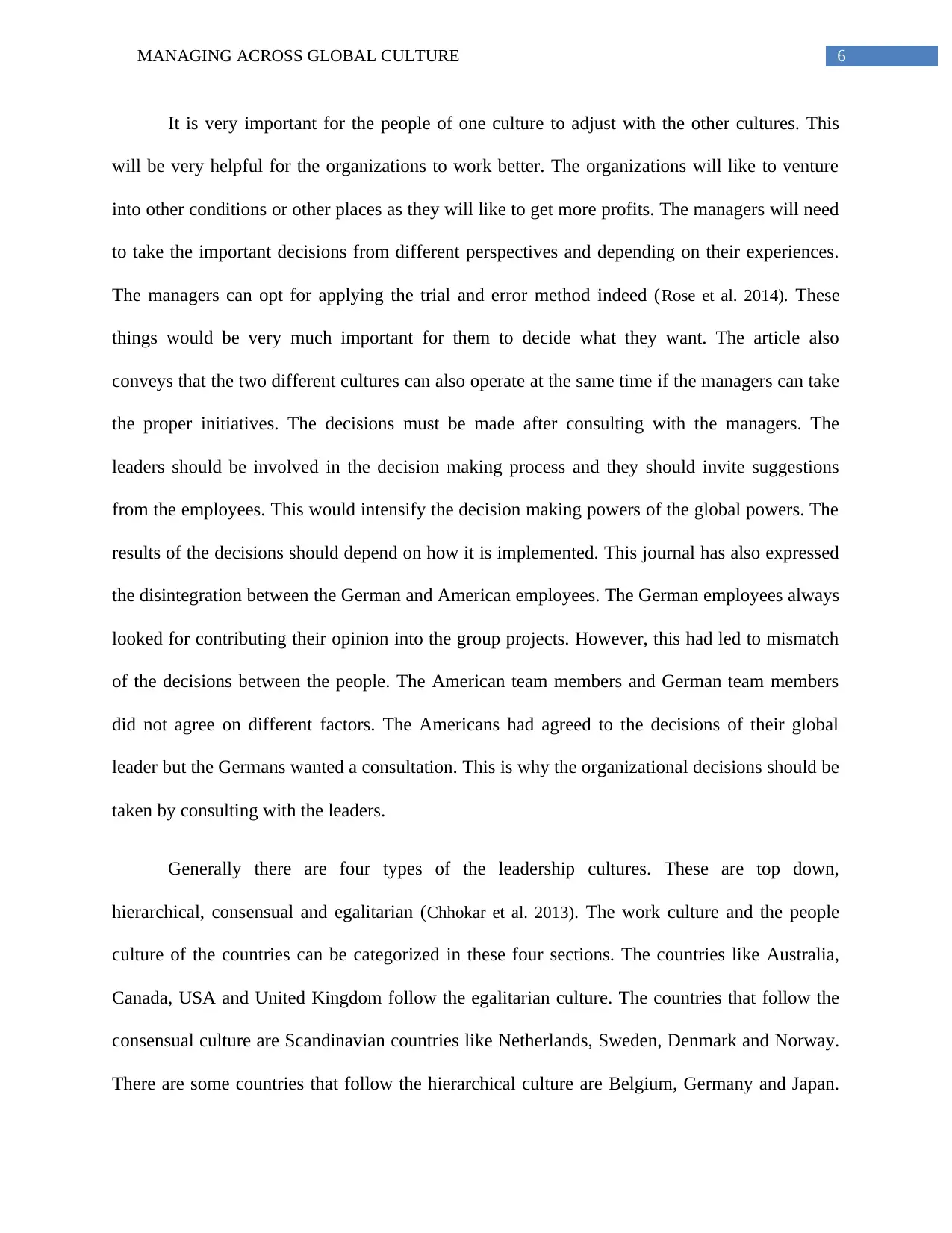
6MANAGING ACROSS GLOBAL CULTURE
It is very important for the people of one culture to adjust with the other cultures. This
will be very helpful for the organizations to work better. The organizations will like to venture
into other conditions or other places as they will like to get more profits. The managers will need
to take the important decisions from different perspectives and depending on their experiences.
The managers can opt for applying the trial and error method indeed (Rose et al. 2014). These
things would be very much important for them to decide what they want. The article also
conveys that the two different cultures can also operate at the same time if the managers can take
the proper initiatives. The decisions must be made after consulting with the managers. The
leaders should be involved in the decision making process and they should invite suggestions
from the employees. This would intensify the decision making powers of the global powers. The
results of the decisions should depend on how it is implemented. This journal has also expressed
the disintegration between the German and American employees. The German employees always
looked for contributing their opinion into the group projects. However, this had led to mismatch
of the decisions between the people. The American team members and German team members
did not agree on different factors. The Americans had agreed to the decisions of their global
leader but the Germans wanted a consultation. This is why the organizational decisions should be
taken by consulting with the leaders.
Generally there are four types of the leadership cultures. These are top down,
hierarchical, consensual and egalitarian (Chhokar et al. 2013). The work culture and the people
culture of the countries can be categorized in these four sections. The countries like Australia,
Canada, USA and United Kingdom follow the egalitarian culture. The countries that follow the
consensual culture are Scandinavian countries like Netherlands, Sweden, Denmark and Norway.
There are some countries that follow the hierarchical culture are Belgium, Germany and Japan.
It is very important for the people of one culture to adjust with the other cultures. This
will be very helpful for the organizations to work better. The organizations will like to venture
into other conditions or other places as they will like to get more profits. The managers will need
to take the important decisions from different perspectives and depending on their experiences.
The managers can opt for applying the trial and error method indeed (Rose et al. 2014). These
things would be very much important for them to decide what they want. The article also
conveys that the two different cultures can also operate at the same time if the managers can take
the proper initiatives. The decisions must be made after consulting with the managers. The
leaders should be involved in the decision making process and they should invite suggestions
from the employees. This would intensify the decision making powers of the global powers. The
results of the decisions should depend on how it is implemented. This journal has also expressed
the disintegration between the German and American employees. The German employees always
looked for contributing their opinion into the group projects. However, this had led to mismatch
of the decisions between the people. The American team members and German team members
did not agree on different factors. The Americans had agreed to the decisions of their global
leader but the Germans wanted a consultation. This is why the organizational decisions should be
taken by consulting with the leaders.
Generally there are four types of the leadership cultures. These are top down,
hierarchical, consensual and egalitarian (Chhokar et al. 2013). The work culture and the people
culture of the countries can be categorized in these four sections. The countries like Australia,
Canada, USA and United Kingdom follow the egalitarian culture. The countries that follow the
consensual culture are Scandinavian countries like Netherlands, Sweden, Denmark and Norway.
There are some countries that follow the hierarchical culture are Belgium, Germany and Japan.
Paraphrase This Document
Need a fresh take? Get an instant paraphrase of this document with our AI Paraphraser
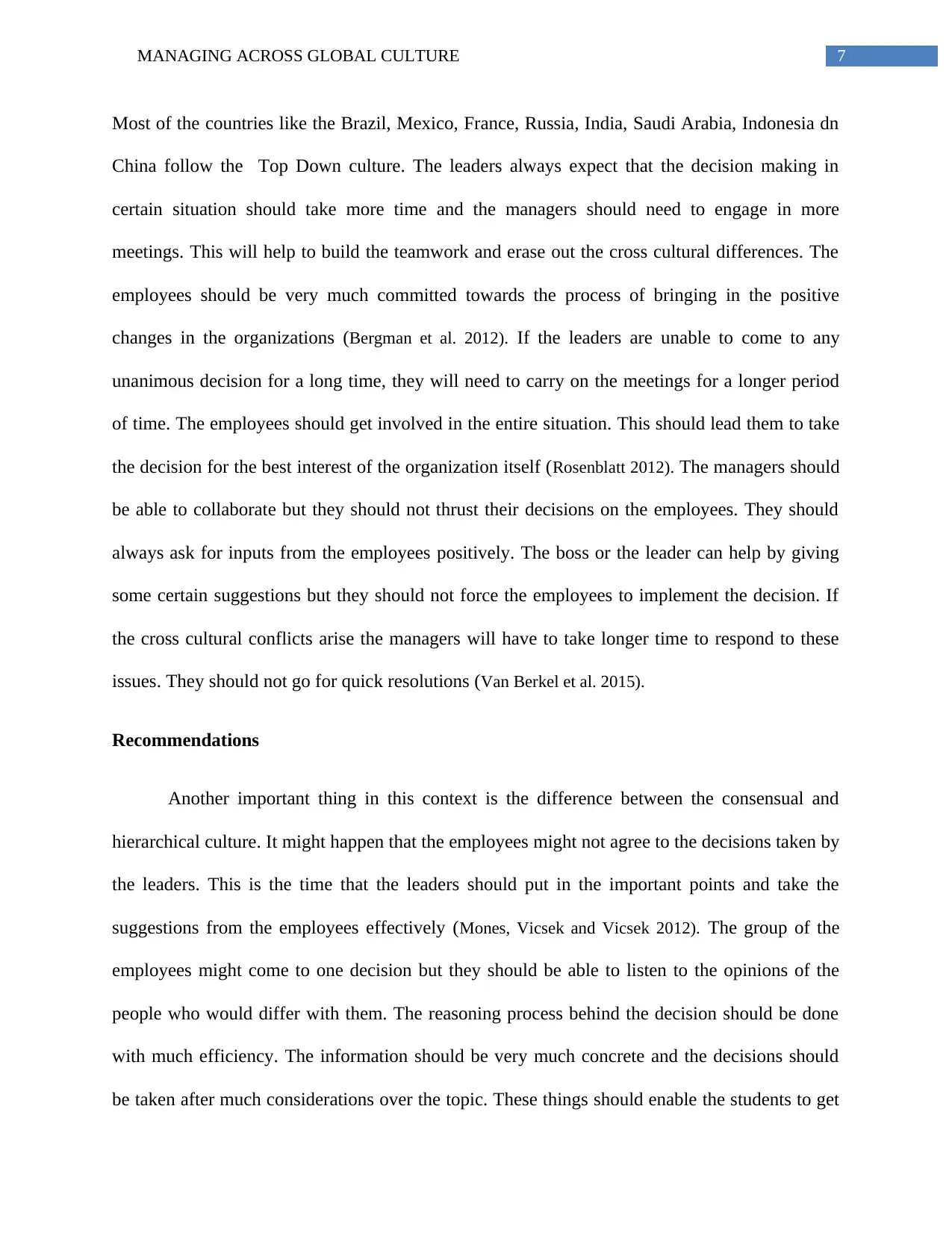
7MANAGING ACROSS GLOBAL CULTURE
Most of the countries like the Brazil, Mexico, France, Russia, India, Saudi Arabia, Indonesia dn
China follow the Top Down culture. The leaders always expect that the decision making in
certain situation should take more time and the managers should need to engage in more
meetings. This will help to build the teamwork and erase out the cross cultural differences. The
employees should be very much committed towards the process of bringing in the positive
changes in the organizations (Bergman et al. 2012). If the leaders are unable to come to any
unanimous decision for a long time, they will need to carry on the meetings for a longer period
of time. The employees should get involved in the entire situation. This should lead them to take
the decision for the best interest of the organization itself (Rosenblatt 2012). The managers should
be able to collaborate but they should not thrust their decisions on the employees. They should
always ask for inputs from the employees positively. The boss or the leader can help by giving
some certain suggestions but they should not force the employees to implement the decision. If
the cross cultural conflicts arise the managers will have to take longer time to respond to these
issues. They should not go for quick resolutions (Van Berkel et al. 2015).
Recommendations
Another important thing in this context is the difference between the consensual and
hierarchical culture. It might happen that the employees might not agree to the decisions taken by
the leaders. This is the time that the leaders should put in the important points and take the
suggestions from the employees effectively (Mones, Vicsek and Vicsek 2012). The group of the
employees might come to one decision but they should be able to listen to the opinions of the
people who would differ with them. The reasoning process behind the decision should be done
with much efficiency. The information should be very much concrete and the decisions should
be taken after much considerations over the topic. These things should enable the students to get
Most of the countries like the Brazil, Mexico, France, Russia, India, Saudi Arabia, Indonesia dn
China follow the Top Down culture. The leaders always expect that the decision making in
certain situation should take more time and the managers should need to engage in more
meetings. This will help to build the teamwork and erase out the cross cultural differences. The
employees should be very much committed towards the process of bringing in the positive
changes in the organizations (Bergman et al. 2012). If the leaders are unable to come to any
unanimous decision for a long time, they will need to carry on the meetings for a longer period
of time. The employees should get involved in the entire situation. This should lead them to take
the decision for the best interest of the organization itself (Rosenblatt 2012). The managers should
be able to collaborate but they should not thrust their decisions on the employees. They should
always ask for inputs from the employees positively. The boss or the leader can help by giving
some certain suggestions but they should not force the employees to implement the decision. If
the cross cultural conflicts arise the managers will have to take longer time to respond to these
issues. They should not go for quick resolutions (Van Berkel et al. 2015).
Recommendations
Another important thing in this context is the difference between the consensual and
hierarchical culture. It might happen that the employees might not agree to the decisions taken by
the leaders. This is the time that the leaders should put in the important points and take the
suggestions from the employees effectively (Mones, Vicsek and Vicsek 2012). The group of the
employees might come to one decision but they should be able to listen to the opinions of the
people who would differ with them. The reasoning process behind the decision should be done
with much efficiency. The information should be very much concrete and the decisions should
be taken after much considerations over the topic. These things should enable the students to get
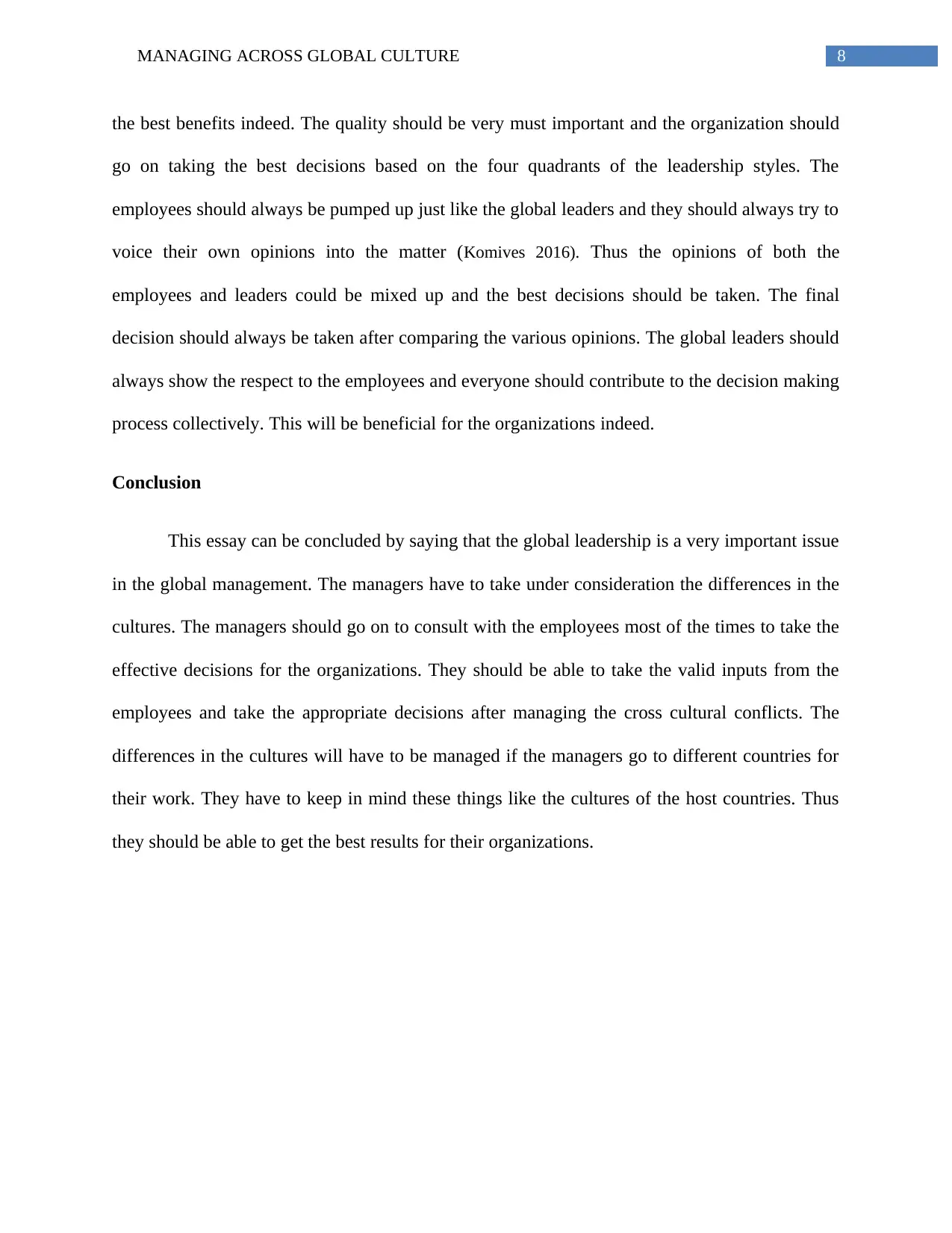
8MANAGING ACROSS GLOBAL CULTURE
the best benefits indeed. The quality should be very must important and the organization should
go on taking the best decisions based on the four quadrants of the leadership styles. The
employees should always be pumped up just like the global leaders and they should always try to
voice their own opinions into the matter (Komives 2016). Thus the opinions of both the
employees and leaders could be mixed up and the best decisions should be taken. The final
decision should always be taken after comparing the various opinions. The global leaders should
always show the respect to the employees and everyone should contribute to the decision making
process collectively. This will be beneficial for the organizations indeed.
Conclusion
This essay can be concluded by saying that the global leadership is a very important issue
in the global management. The managers have to take under consideration the differences in the
cultures. The managers should go on to consult with the employees most of the times to take the
effective decisions for the organizations. They should be able to take the valid inputs from the
employees and take the appropriate decisions after managing the cross cultural conflicts. The
differences in the cultures will have to be managed if the managers go to different countries for
their work. They have to keep in mind these things like the cultures of the host countries. Thus
they should be able to get the best results for their organizations.
the best benefits indeed. The quality should be very must important and the organization should
go on taking the best decisions based on the four quadrants of the leadership styles. The
employees should always be pumped up just like the global leaders and they should always try to
voice their own opinions into the matter (Komives 2016). Thus the opinions of both the
employees and leaders could be mixed up and the best decisions should be taken. The final
decision should always be taken after comparing the various opinions. The global leaders should
always show the respect to the employees and everyone should contribute to the decision making
process collectively. This will be beneficial for the organizations indeed.
Conclusion
This essay can be concluded by saying that the global leadership is a very important issue
in the global management. The managers have to take under consideration the differences in the
cultures. The managers should go on to consult with the employees most of the times to take the
effective decisions for the organizations. They should be able to take the valid inputs from the
employees and take the appropriate decisions after managing the cross cultural conflicts. The
differences in the cultures will have to be managed if the managers go to different countries for
their work. They have to keep in mind these things like the cultures of the host countries. Thus
they should be able to get the best results for their organizations.
⊘ This is a preview!⊘
Do you want full access?
Subscribe today to unlock all pages.

Trusted by 1+ million students worldwide
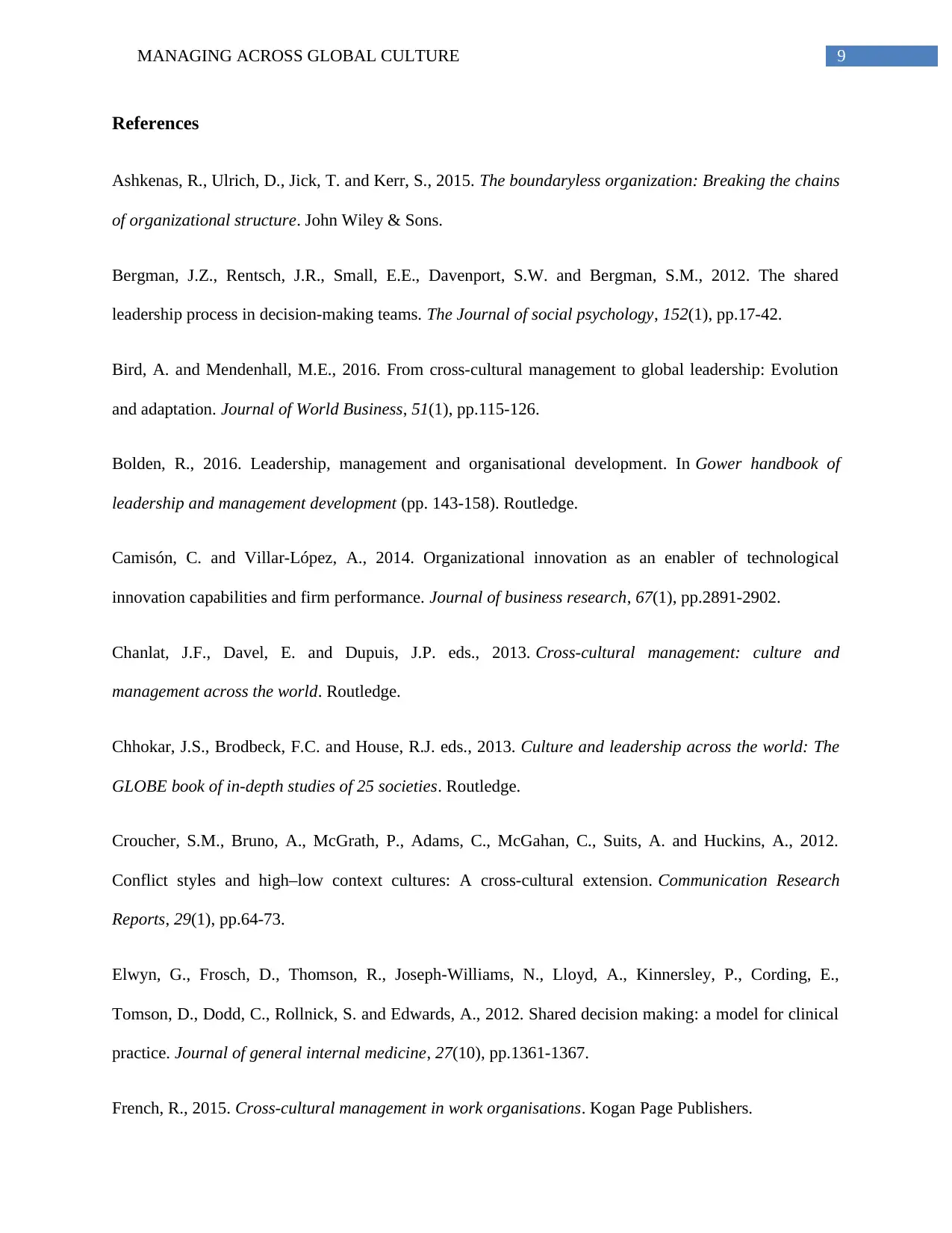
9MANAGING ACROSS GLOBAL CULTURE
References
Ashkenas, R., Ulrich, D., Jick, T. and Kerr, S., 2015. The boundaryless organization: Breaking the chains
of organizational structure. John Wiley & Sons.
Bergman, J.Z., Rentsch, J.R., Small, E.E., Davenport, S.W. and Bergman, S.M., 2012. The shared
leadership process in decision-making teams. The Journal of social psychology, 152(1), pp.17-42.
Bird, A. and Mendenhall, M.E., 2016. From cross-cultural management to global leadership: Evolution
and adaptation. Journal of World Business, 51(1), pp.115-126.
Bolden, R., 2016. Leadership, management and organisational development. In Gower handbook of
leadership and management development (pp. 143-158). Routledge.
Camisón, C. and Villar-López, A., 2014. Organizational innovation as an enabler of technological
innovation capabilities and firm performance. Journal of business research, 67(1), pp.2891-2902.
Chanlat, J.F., Davel, E. and Dupuis, J.P. eds., 2013. Cross-cultural management: culture and
management across the world. Routledge.
Chhokar, J.S., Brodbeck, F.C. and House, R.J. eds., 2013. Culture and leadership across the world: The
GLOBE book of in-depth studies of 25 societies. Routledge.
Croucher, S.M., Bruno, A., McGrath, P., Adams, C., McGahan, C., Suits, A. and Huckins, A., 2012.
Conflict styles and high–low context cultures: A cross-cultural extension. Communication Research
Reports, 29(1), pp.64-73.
Elwyn, G., Frosch, D., Thomson, R., Joseph-Williams, N., Lloyd, A., Kinnersley, P., Cording, E.,
Tomson, D., Dodd, C., Rollnick, S. and Edwards, A., 2012. Shared decision making: a model for clinical
practice. Journal of general internal medicine, 27(10), pp.1361-1367.
French, R., 2015. Cross-cultural management in work organisations. Kogan Page Publishers.
References
Ashkenas, R., Ulrich, D., Jick, T. and Kerr, S., 2015. The boundaryless organization: Breaking the chains
of organizational structure. John Wiley & Sons.
Bergman, J.Z., Rentsch, J.R., Small, E.E., Davenport, S.W. and Bergman, S.M., 2012. The shared
leadership process in decision-making teams. The Journal of social psychology, 152(1), pp.17-42.
Bird, A. and Mendenhall, M.E., 2016. From cross-cultural management to global leadership: Evolution
and adaptation. Journal of World Business, 51(1), pp.115-126.
Bolden, R., 2016. Leadership, management and organisational development. In Gower handbook of
leadership and management development (pp. 143-158). Routledge.
Camisón, C. and Villar-López, A., 2014. Organizational innovation as an enabler of technological
innovation capabilities and firm performance. Journal of business research, 67(1), pp.2891-2902.
Chanlat, J.F., Davel, E. and Dupuis, J.P. eds., 2013. Cross-cultural management: culture and
management across the world. Routledge.
Chhokar, J.S., Brodbeck, F.C. and House, R.J. eds., 2013. Culture and leadership across the world: The
GLOBE book of in-depth studies of 25 societies. Routledge.
Croucher, S.M., Bruno, A., McGrath, P., Adams, C., McGahan, C., Suits, A. and Huckins, A., 2012.
Conflict styles and high–low context cultures: A cross-cultural extension. Communication Research
Reports, 29(1), pp.64-73.
Elwyn, G., Frosch, D., Thomson, R., Joseph-Williams, N., Lloyd, A., Kinnersley, P., Cording, E.,
Tomson, D., Dodd, C., Rollnick, S. and Edwards, A., 2012. Shared decision making: a model for clinical
practice. Journal of general internal medicine, 27(10), pp.1361-1367.
French, R., 2015. Cross-cultural management in work organisations. Kogan Page Publishers.
Paraphrase This Document
Need a fresh take? Get an instant paraphrase of this document with our AI Paraphraser
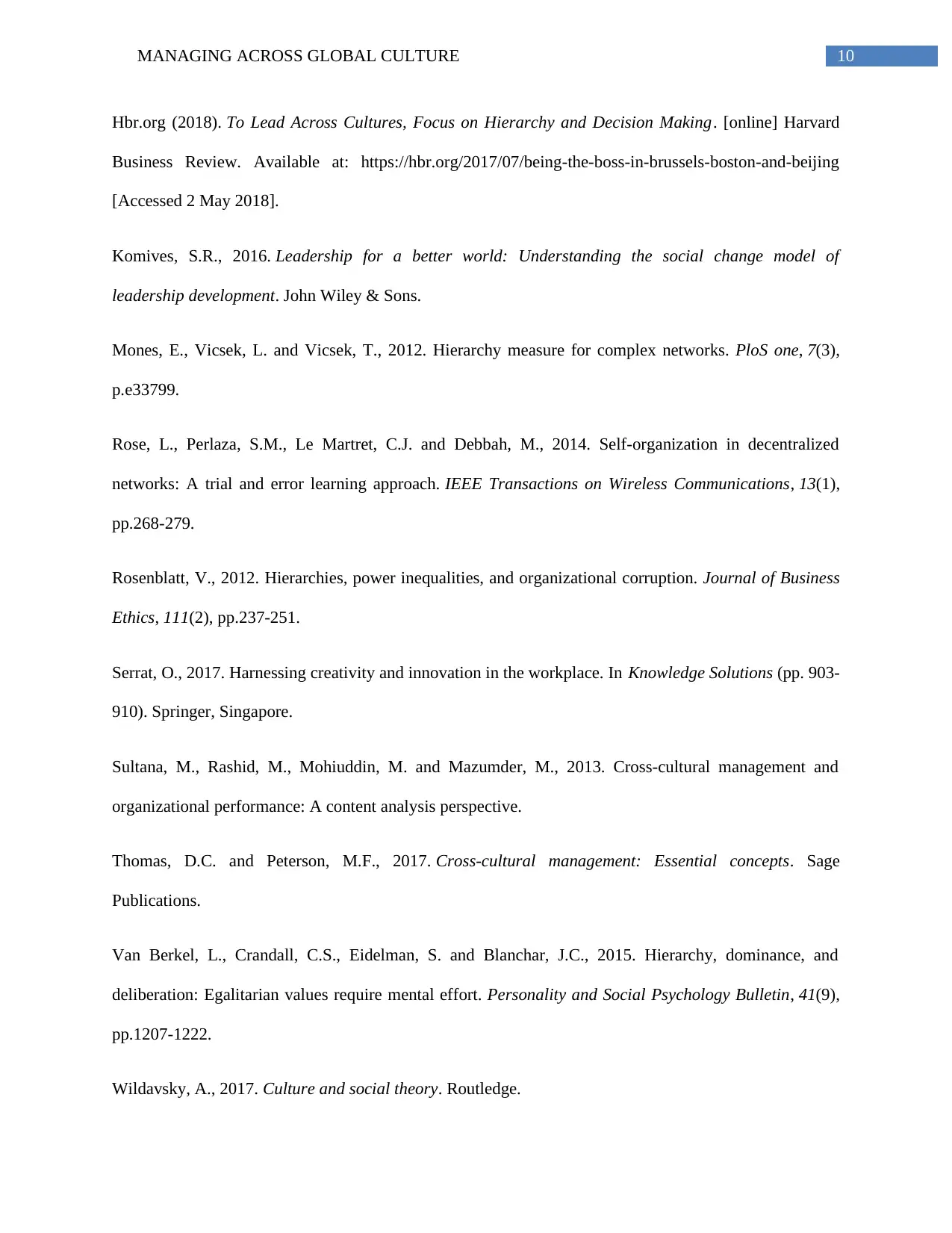
10MANAGING ACROSS GLOBAL CULTURE
Hbr.org (2018). To Lead Across Cultures, Focus on Hierarchy and Decision Making. [online] Harvard
Business Review. Available at: https://hbr.org/2017/07/being-the-boss-in-brussels-boston-and-beijing
[Accessed 2 May 2018].
Komives, S.R., 2016. Leadership for a better world: Understanding the social change model of
leadership development. John Wiley & Sons.
Mones, E., Vicsek, L. and Vicsek, T., 2012. Hierarchy measure for complex networks. PloS one, 7(3),
p.e33799.
Rose, L., Perlaza, S.M., Le Martret, C.J. and Debbah, M., 2014. Self-organization in decentralized
networks: A trial and error learning approach. IEEE Transactions on Wireless Communications, 13(1),
pp.268-279.
Rosenblatt, V., 2012. Hierarchies, power inequalities, and organizational corruption. Journal of Business
Ethics, 111(2), pp.237-251.
Serrat, O., 2017. Harnessing creativity and innovation in the workplace. In Knowledge Solutions (pp. 903-
910). Springer, Singapore.
Sultana, M., Rashid, M., Mohiuddin, M. and Mazumder, M., 2013. Cross-cultural management and
organizational performance: A content analysis perspective.
Thomas, D.C. and Peterson, M.F., 2017. Cross-cultural management: Essential concepts. Sage
Publications.
Van Berkel, L., Crandall, C.S., Eidelman, S. and Blanchar, J.C., 2015. Hierarchy, dominance, and
deliberation: Egalitarian values require mental effort. Personality and Social Psychology Bulletin, 41(9),
pp.1207-1222.
Wildavsky, A., 2017. Culture and social theory. Routledge.
Hbr.org (2018). To Lead Across Cultures, Focus on Hierarchy and Decision Making. [online] Harvard
Business Review. Available at: https://hbr.org/2017/07/being-the-boss-in-brussels-boston-and-beijing
[Accessed 2 May 2018].
Komives, S.R., 2016. Leadership for a better world: Understanding the social change model of
leadership development. John Wiley & Sons.
Mones, E., Vicsek, L. and Vicsek, T., 2012. Hierarchy measure for complex networks. PloS one, 7(3),
p.e33799.
Rose, L., Perlaza, S.M., Le Martret, C.J. and Debbah, M., 2014. Self-organization in decentralized
networks: A trial and error learning approach. IEEE Transactions on Wireless Communications, 13(1),
pp.268-279.
Rosenblatt, V., 2012. Hierarchies, power inequalities, and organizational corruption. Journal of Business
Ethics, 111(2), pp.237-251.
Serrat, O., 2017. Harnessing creativity and innovation in the workplace. In Knowledge Solutions (pp. 903-
910). Springer, Singapore.
Sultana, M., Rashid, M., Mohiuddin, M. and Mazumder, M., 2013. Cross-cultural management and
organizational performance: A content analysis perspective.
Thomas, D.C. and Peterson, M.F., 2017. Cross-cultural management: Essential concepts. Sage
Publications.
Van Berkel, L., Crandall, C.S., Eidelman, S. and Blanchar, J.C., 2015. Hierarchy, dominance, and
deliberation: Egalitarian values require mental effort. Personality and Social Psychology Bulletin, 41(9),
pp.1207-1222.
Wildavsky, A., 2017. Culture and social theory. Routledge.

11MANAGING ACROSS GLOBAL CULTURE
⊘ This is a preview!⊘
Do you want full access?
Subscribe today to unlock all pages.

Trusted by 1+ million students worldwide
1 out of 12
Related Documents
Your All-in-One AI-Powered Toolkit for Academic Success.
+13062052269
info@desklib.com
Available 24*7 on WhatsApp / Email
![[object Object]](/_next/static/media/star-bottom.7253800d.svg)
Unlock your academic potential
Copyright © 2020–2025 A2Z Services. All Rights Reserved. Developed and managed by ZUCOL.





